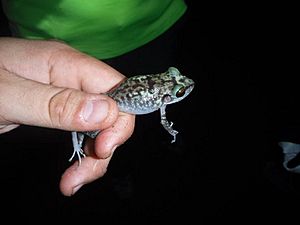Eleutherodactylus pinarensis facts for kids
Quick facts for kids Eleutherodactylus pinarensis |
|
|---|---|
 |
|
| Conservation status | |
| Scientific classification | |
| Synonyms | |
|
Euhyas pinarensis (Dunn, 1926) |
The Pinos robber frog (scientific name: Eleutherodactylus pinarensis) is a special type of frog that lives only in Cuba. It is found in the western part of the island and also on a smaller island called Isla de la Juventud. This frog is part of a big family of frogs called Eleutherodactylidae. It was first described in 1926.
Contents
About the Pinos Robber Frog
The Pinos robber frog is a fairly large frog. It has a large eardrum, called a tympanum, which is almost as big as its eye. Its fingers have special pads, called disks, on the third and fourth fingers. Its toes do not have any webbing between them.
Appearance and Skin
The skin on the frog's back is evenly textured and feels a bit rough, like sandpaper. This is called shagreened. Its belly is slightly bumpy. The frog's colors are a mix of dark and light shades, often looking marbled. You might also see hints of stripes across its body or light lines along its back.
Where the Frog Lives and How It's Protected
The Pinos robber frog lives in specific places in Cuba. It likes rocky areas, cliffs near the coast, and caves. These frogs are always found in forests that have a good amount of moisture. They do not live outside of forest habitats.
Conservation Status
This frog is considered an uncommon species, meaning it is not found everywhere and can be hard to spot. Its home is sometimes disturbed by activities related to tourism, such as building new hotels or other structures. This can harm the frog's natural environment.
Protected Areas
Luckily, the Pinos robber frog lives in several protected areas. One important place where it is found is the Guanahacabibes National Park. These protected areas help keep the frogs safe and preserve their natural homes.
See also
 In Spanish: Eleutherodactylus pinarensis para niños
In Spanish: Eleutherodactylus pinarensis para niños


